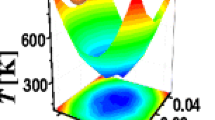Abstract.
A simple model of a trapped ion cloud cooled by collisions in a buffer gas in a Paul trap is presented. It is based on the customary decomposition of the ion motion in micro- and macro- (or secular) motions and a statistical treatment of hard-sphere collisions and ion trajectories. The model also relies on the evidence that the effective trapping area in real Paul traps is limited to a certain radius, where the harmonics of the potential of order \(> 2\) become non negligible. The model yields analytical formulae for the properties of the ion cloud and equilibration times, which are in good agreement for a wide range of parameters with the results of a numerical simulation, whose reliability has been verified. When the confining potential is efficient enough to suppress evaporation from the trap, the model yields an effective temperature for the ions \(T_{eff}=2T/(1-\frac{m_{g}}{m})\), where T is the temperature of the buffer gas, m and \(m_{g}\) are the masses of the ions and gas molecules, respectively. The so-called Radio Frequency (RF) heating effect, responsible for \( T_{eff} > T\), is interpreted in light of the model as the result of an incomplete cooling of the ion motion, limited to the macromotion, while the net effect of the micromotion is to double the average ion kinetic energy for \(\frac{m}{m_{g}}\gg 1\). For \( \frac{m}{m_{g}} \le 1\), the incomplete cooling is not sufficient to overcome the thermal agitation of the cloud to which the micromotion participates; the ions are therefore led out of the trap. When a thermal equilibrium is found, the dimensions of the cloud are shown to be proportional to the square root of the effective temperature: \(\sigma_{x}=\sigma_{y}=\sigma_{r}=2\sigma_{z} \propto\sqrt{T_{eff}}\). In the frame of the model, the number of collisions required for the complete cooling of the ion cloud is simply approximated by \(\frac{m}{\mu}\cdot 3.5\), where μ is the reduced mass of the system. When the confining potential does not prevent evaporation from the trap, an approximate formula is derived for the evaporation rate that primarily depends on the ratio of the maximal energies of ions that can be trapped to the ion thermal energies. The comparison of the characteristic times of both processes permits to predict if the ion cloud will reach a thermal equilibrium before being evaporated.
Similar content being viewed by others
References
D. Lunney, The phase space volume of ion clouds in Paul traps, PhD Thesis, McGill University, Montreal, Canada (1992)
M. Schubert, I. Siemers, R. Blatt, Appl. Phys. B 51, 414 (1990)
F. Vedel, Int. J. Mass Spectrom. Ion Proc. 106, 33 (1991)
H.G. Dehmelt, Adv. At. Mol. Phys. 3, 53 (1968)
I. Siemers, R. Blatt, T. Sauter, W. Neuhauser, Phys. Rev. A 38, 38 (1988)
Y.S. Nam, D.K. Weiss, R. Blümel, Phys. Lett. A 381, 3477 (2017)
S. Gronert, J. Am. Soc. Mass Spectrom. 9, 845 (1998)
W.A. Donald, G.N. Khairallah, R.A.J. O'Hair, J. Am. Soc. Mass Spectrom. 24, 811 (2013)
D.E. Goeringer, S.A. McLuckey, J. Chem. Phys. 104, 2214 (1996)
X. Fabian, F. Mauger, G. Quéméner, Ph. Velten, G. Ban, C. Couratin, P. Delahaye, D. Durand, B. Fabre, P. Finlay et al., Hyperfine Interact. 235, 87 (2015)
F.G. Major, H.G. Dehmelt, Phys. Rev. 170, 91 (1968)
E. Liénard, G. Ban, C. Couratin, P. Delahaye, D. Durand et al., Hyperfine Interact. 236, 1 (2015)
P. Delahaye, to be published in Hyperfine Interact
P. Delahaye, G. Ban, M. Benali, D. Durand, X. Fabian, X. Fléchard, M. Herbane, E. Liénard, A. Mery, Y. Merrer, G. Quemener, B.M. Retailleau, D. Rodriguez, J.C. Thomas, P. Ujic, The open LPC Paul trap for precision measurement in beta decay, to be published in Eur. Phys. J. A, arXiv:1810.09246 [physics.ins-det]
R.E. March, J.F.J. Todd, Quadrupole Ion Trap Mass Spectrometry, in Chemical Analysis, a series of monographs on analytical chemistry and its applications, edited by J.D. Winefordner (Wiley, 2005)
R. Alheit, S. Kleineidam, F. Vedel, M. Vedel, G. Werth, Int. J. Mass Spectrom. Ion Proc. 154, 155 (1996)
L.A. Viehland, E.A. Mason, At. Nucl. Data Tables 60, 37 (1995)
T. Kim, Buffer gas cooling of ions in an RF ion guide: a study of the cooling process and cooled beam properties, PhD Thesis, McGill University, Montreal (1997)
S. Schwarz, Nucl. Instrum. Methods A 566, 233 (2006)
G. Ban, G. Darius, D. Durand, X. Fléchard, M. Herbane, M. Labalme, E. Liénard, F. Mauger, O. Naviliat-Cuncic, C. Guénault et al., Nucl. Instrum. Methods A 518, 712 (2004)
A. Kellerbauer, T. Kim, R.B. Moore, P. Varfalvy, Nucl. Instrum. Methods A 469, 276 (2001)
R.G. DeVoe, Phys. Rev. Lett. 102, 063001 (2009)
Wolfram Research, Inc., Mathematica, Version 11.3 (2018)
Author information
Authors and Affiliations
Corresponding author
Additional information
Communicated by K. Blaum
Data Availability Statement
This manuscript has no associated data or the data will not be deposited. [Author's comment: All data generated during this study are contained in this published article, the specific example of LPCTrap used for this study can easily be reproduced by any hard sphere calculation.]
Publisher's Note
The EPJ Publishers remain neutral with regard to jurisdictional claims in published maps and institutional affiliations.
Rights and permissions
About this article
Cite this article
Delahaye, P. Analytical model of an ion cloud cooled by collisions in a Paul trap. Eur. Phys. J. A 55, 83 (2019). https://doi.org/10.1140/epja/i2019-12740-4
Received:
Accepted:
Published:
DOI: https://doi.org/10.1140/epja/i2019-12740-4




